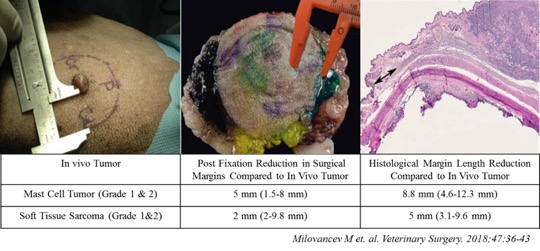
September 2019
Using In vivo and Histological Surgical Margins in Canine Skin Tumors: Mast cell tumors and Soft Tissue Sarcomas (Grades I and II)
By Dr. Charan Ganta
Surgical removal of tumors is the primary mode of therapy for several skin tumors, provided the surgical margins are free of neoplastic cells. This article is a brief review based on a recent publication that focused on the evaluation of surgical margins in two of the most commonly diagnosed canine skin tumors, grade 1 and 2 cutaneous mast cell tumors (MCT) and soft tissue sarcomas (STS).
Several factors cause the in vivo surgical margins to be longer than the histopathological surgical margins reported by a pathologist. These factors include separation of deeper anatomic layers from the skin, type of tumor, method of histologic sectioning and patient factors.

|
SUMMARY
- Circumferential surgical margins for both MCT and STS are on average are 8.8 mm and 5 mm smaller, respectively, for histopathologic length vs. in vivo tumor length. The difference in shorter histological length is due to biological variation. MCT often contain more edema, necrosis, collagenolysis, fibrosis, and inflammation compared to STS which usually lack reactive changes adjacent to the tumor margins.
- In addition, a greater reduction in MCT histopathological margin size is attributed to the infiltrative nature of the neoplastic cells, thus demanding more surgical margins compared to STS.
- The tumor depth is another important factor that determines the completeness of surgical excision. This remains unchanged between in vivo and post-fixation gross surgical margins, but tumor depth is reduced in MCT’s (1 mm) compared to STS (0.5) due to the infiltrative nature of MCTs.
- There is no significant reduction in the size of the tumor length along the dorsal, ventral, cranial, caudal planes and the reduction is not influenced by the location of the tumor (truncal vs appendicular), suggesting a uniform shrinkage of tumor in all directions except for deep surgical margins, where the deep margin length remains unchanged.
The above criteria of tumor shrinkage may not apply to all Grade 3, MCTs and STSs as these tumors can be highly infiltrative and often have metastatic lesions by the time of clinical diagnosis, often requiring additional therapeutic interventions besides surgical resection.
Stay tuned for the next newsletter of dermpath focus with recommended histopathological surgical margins for various skin tumors in dogs. References will be provided upon request.
Questions, please contact ckganta@vet.k-state.edu
Dr. Ganta is a board certified anatomic pathologist in the KSVDL.